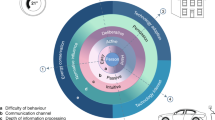Abstract
This paper presents a novel model for simulating peer pressure effect on energy awareness and consumption of families. The model is built on two well-established theories of human behaviour to obtain realistic peer effect: the collective behaviour theory and the theory of cognitive dissonance. These theories are implemented in a collective agent-based model that produces fine-grained behaviour and consumption data based on social parameters. The model enables the application of different energy efficiency interventions which aim to obtain more aware occupants and achieve more energy saving. The presented experiments show that the implemented model reflects the human behaviour theories. They also provide examples of how the model can be used as an analytical tool to interpret the effect of energy interventions in the given social parameters and decide the optimal intervention needed in different cases.
Access this chapter
Tax calculation will be finalised at checkout
Purchases are for personal use only
Similar content being viewed by others
Notes
- 1.
The model was validated by running a number of scenarios with different random numbers seed where the results came out to be similar.
References
US Global Cilmate Change Research Program (USGCRP): Global Climate Change. In: Global Climate Change Impacts in the United States, pp. 13–26. Cambridge University Press, New York (2009)
Internation Energy Agency (IEA): Electricity Information Overview 2017. Technical report, IEA (2017)
Zipperer, A., Aloise-Young, P.A., Suryanarayanan, S., Roche, R., Earle, L., Christensen, D., Bauleo, P., Zimmerle, D.: Electric energy management in the smart home: perspectives on enabling technologies and consumer behavior. Proc. IEEE 101(11), 2397–2408 (2013)
Nolan, J.M., Schultz, P.W., Cialdini, R.B., Goldstein, N.J., Griskevicius, V.: Normative social influence is underestimated. Pers. Soc. Psychol. Bull. 34(7), 913–923 (2008)
Granovetter, M.: Threshold models of collective behaviour. Am. J. Sociol. 83(6), 1420–1443 (1978)
Festinger, L.: A Theory of Cognitive Dissonance, vol. 2, 2nd edn. Stanford University Press, Stanford (1962)
Epstein, J.M.: Agent-based computational models and generative social science. Complexity 4(5), 41–60 (1999)
Axtell, R.: Why agents? on the varied motivations for agent computing in the social sciences. The Brookings Institution, Technical report, Center on Social and Economics Dynamics (2000)
Azar, E., Menassa, C.C.: Agent-based modeling of occupants and their impact on energy use in commercial buildings. J. Comput. Civil Eng. 26(4), 506–518 (2012)
Chen, J., Taylor, J.E., Wei, H.H.: Modeling building occupant network energy consumption decision-making: the interplay between network structure and conservation. Energy Build. 47, 515–524 (2012)
Azar, E., Menassa, C.C.: A comprehensive framework to quantify energy savings potential from improved operations of commercial building stocks. Energy Policy 67, 459–472 (2014)
Hu, H.H., Lin, J., Cui, W.T.: Intervention strategies and the diffusion of collective behavior. J. Artif. Soc. Soc. Simul. 18(3) (2015). Paper 16. http://www.jasss.soc.surrey.ac.uk/18/3/16.html
Abrahamse, W., Steg, L., Vlek, C., Rothengatter, T.: A review of intervention studies aimed at household energy conservation. J. Env. Psychol. 25(3), 273–291 (2005)
Costanzo, M., Archer, D., Aronson, E., Pettigrew, T.: Energy Conservation Behavior. The Difficult Path From Information to Action. Am. Psychol. 41(5), 521–528 (1986)
Abdallah, F., Basurra, S., Gaber, M.M.: A hybrid agent-based and probabilistic model for fine-grained behavioural energy waste simulation. In: IEEE 29th International Conference on Tools with Artificial Intelligence (ICTAI), pp. 991–995. IEEE (2017)
Abdallah, F., Basurra, S., Gaber, M.M.: Cascading probability distributions in agent-based models: an application to behavioural energy wastage. In: Rutkowski, L., Scherer, R., Korytkowski, M., Pedrycz, W., Tadeusiewicz, R., Zurada, J.M. (eds.) ICAISC 2018. LNCS (LNAI), vol. 10842, pp. 489–503. Springer, Cham (2018). https://doi.org/10.1007/978-3-319-91262-2_44
Kiesling, E., Günther, M., Stummer, C., Wakolbinger, L.M.: Agent-based simulation of innovation diffusion: a review. Central Eur. J. Oper. 20(2), 183–230 (2012)
Bohlmann, J.D., Calantone, R.J., Zhao, M.: The effects of market network heterogeneity on innovation diffusion: an agent-based modeling approach. J. Prod. Innov. Manag. 27(5), 741–760 (2010)
Author information
Authors and Affiliations
Corresponding author
Editor information
Editors and Affiliations
Rights and permissions
Copyright information
© 2018 Springer Nature Switzerland AG
About this paper
Cite this paper
Abdallah, F., Basurra, S., Gaber, M.M. (2018). An Agent-Based Collective Model to Simulate Peer Pressure Effect on Energy Consumption. In: Nguyen, N., Pimenidis, E., Khan, Z., Trawiński, B. (eds) Computational Collective Intelligence. ICCCI 2018. Lecture Notes in Computer Science(), vol 11055. Springer, Cham. https://doi.org/10.1007/978-3-319-98443-8_26
Download citation
DOI: https://doi.org/10.1007/978-3-319-98443-8_26
Published:
Publisher Name: Springer, Cham
Print ISBN: 978-3-319-98442-1
Online ISBN: 978-3-319-98443-8
eBook Packages: Computer ScienceComputer Science (R0)




